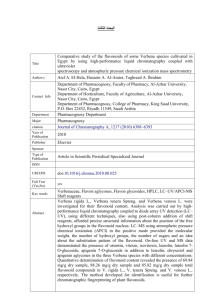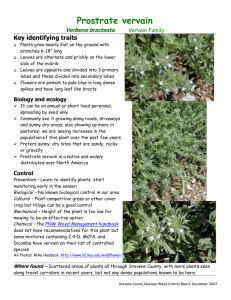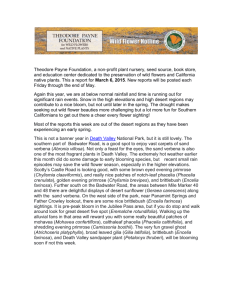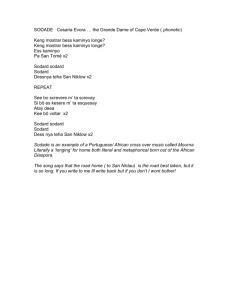Is Verbena abramsii distinct from V. lasiostachys
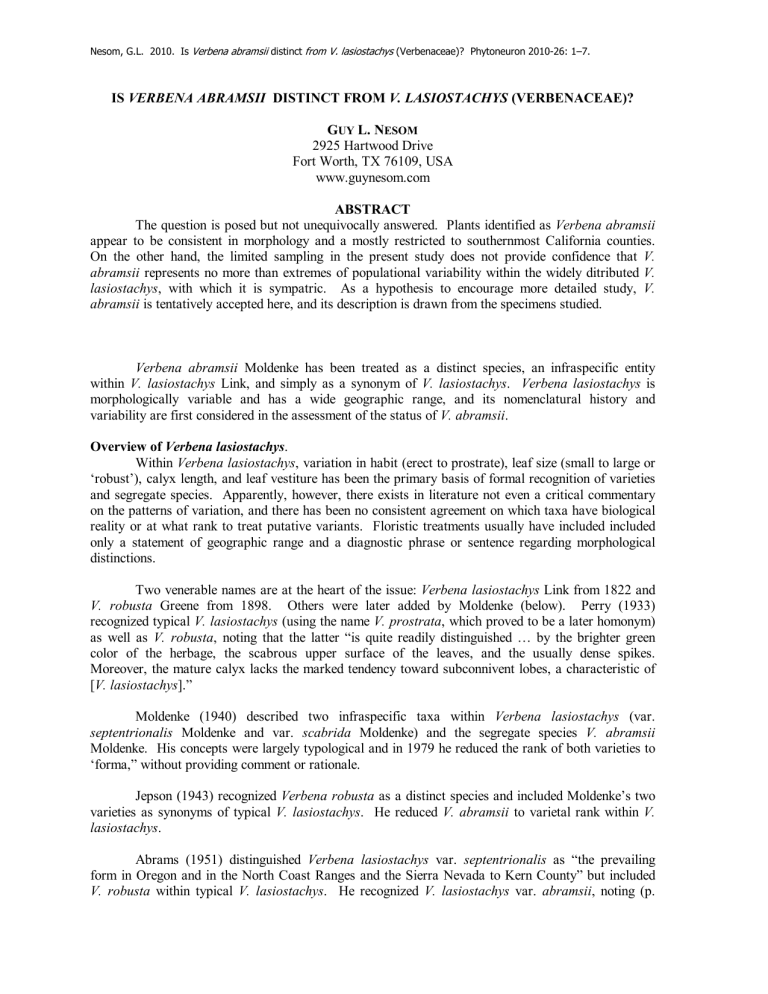
Nesom, G.L. 2010. Is Verbena abramsii distinct from V. lasiostachys (Verbenaceae)? Phytoneuron 2010-26: 1–7.
IS VERBENA ABRAMSII DISTINCT FROM V. LASIOSTACHYS (VERBENACEAE)?
G UY L. N ESOM
2925 Hartwood Drive
Fort Worth, TX 76109, USA www.guynesom.com
ABSTRACT
The question is posed but not unequivocally answered. Plants identified as Verbena abramsii appear to be consistent in morphology and a mostly restricted to southernmost California counties.
On the other hand, the limited sampling in the present study does not provide confidence that V.
abramsii represents no more than extremes of populational variability within the widely ditributed V.
lasiostachys, with which it is sympatric. As a hypothesis to encourage more detailed study, V.
abramsii is tentatively accepted here, and its description is drawn from the specimens studied.
Verbena abramsii Moldenke has been treated as a distinct species, an infraspecific entity within V. lasiostachys Link, and simply as a synonym of V. lasiostachys. Verbena lasiostachys is morphologically variable and has a wide geographic range, and its nomenclatural history and variability are first considered in the assessment of the status of V. abramsii.
Overview of Verbena lasiostachys.
Within Verbena lasiostachys, variation in habit (erect to prostrate), leaf size (small to large or
‘robust’), calyx length, and leaf vestiture has been the primary basis of formal recognition of varieties and segregate species. Apparently, however, there exists in literature not even a critical commentary on the patterns of variation, and there has been no consistent agreement on which taxa have biological reality or at what rank to treat putative variants. Floristic treatments usually have included included only a statement of geographic range and a diagnostic phrase or sentence regarding morphological distinctions.
Two venerable names are at the heart of the issue: Verbena lasiostachys Link from 1822 and
V. robusta Greene from 1898. Others were later added by Moldenke (below). Perry (1933) recognized typical V. lasiostachys (using the name V. prostrata, which proved to be a later homonym) as well as V. robusta, noting that the latter “is quite readily distinguished … by the brighter green color of the herbage, the scabrous upper surface of the leaves, and the usually dense spikes.
Moreover, the mature calyx lacks the marked tendency toward subconnivent lobes, a characteristic of
[V. lasiostachys].”
Moldenke (1940) described two infraspecific taxa within Verbena lasiostachys (var.
septentrionalis Moldenke and var. scabrida Moldenke) and the segregate species V. abramsii
Moldenke. His concepts were largely typological and in 1979 he reduced the rank of both varieties to
‘forma,” without providing comment or rationale.
Jepson (1943) recognized Verbena robusta as a distinct species and included Moldenke’s two varieties as synonyms of typical V. lasiostachys. He reduced V. abramsii to varietal rank within V.
lasiostachys.
Abrams (1951) distinguished Verbena lasiostachys var. septentrionalis as “the prevailing form in Oregon and in the North Coast Ranges and the Sierra Nevada to Kern County” but included
V. robusta within typical V. lasiostachys. He recognized V. lasiostachys var. abramsii, noting (p.
Nesom: Is Verbena abramsii distinct? 2
611) that “This form, described originally from San Diego County, occurs also in the southern Sierra
Nevada, and on the desert slopes of the mountains of southern California, especially of the San
Gabriel and San Bernadino Ranges.”
Munz and Keck (1959) treated Verbena robusta Greene as a distinct species from “Marin and
Tuolumne cos. to San Diego Co.; n L. Calif.,” based on the distinctions in his associated key and geographical summaries.
1. “Spikes 0.3–1 dm long in fr.; lvs. bright green, scabrous above, inner face of nutlets with whitish papillae;
Marin and Tuolumne cos. to San Diego Co.; n. L. Calif.” ................................................ Verbena robusta
1. “Spikes 1–3 dm long in fr.; lvs. canescent, not scabrous above; inner face of nutlets without whitish papillae; most of cismontane Calif.; to Ore., n. L. Calif.” ......................................... Verbena lasiostachys
Using essentially the same contrast as Munz and Keck, Wilken (1993) also recognized two entities within the Verbena lasiostachys complex but treated them at varietal rank: V. lasiostachys var.
lasiostachys (including V. abramsii as a synonym) and var. scabrida (including V. robusta as a synonym). He noted that the “Vars. need further study.”
O’Leary et al. (2010) regard Verbena lasiostachys as broadly defined (including V. robusta) and without formal infraspecific variants. They place V. abramsii as a synonym of V. neomexicana var. hirtella Perry, an entity mostly of Texas and southern Chihuahua (not reaching New Mexico,
Arizona, California, Sonora, or Baja California).
VERBENA LASIOSTACHYS Link, Enum. Hort. Berol. Alt. 2: 122. 1822. T YPE : Link’s protologue noted only “Habitat in California.” N EOTYPE TO BE DESIGNATED (O’Leary et al.
2010): USA. California.
Verbena prostrata R. Br. in W.T. Aiton, Hort. Kew. ed. 2, 4: 41. 1812 (not V. prostrata G. Savi
1802). T YPE (the protologue): “Nat. of the North West Coast of America. Archibald
Menzies, Esq. Introd. 1794. Fl. June and July” (holotype: K?).
Verbena robusta Greene, Pittonia 3: 309. 1898. T YPE : USA. California. Marin Co.: Point Isabel E shore and Pt. Tiburon, 20 Jul 1891, E.L. Greene s.n. (holotype: ND-G, fide O’Leary et al.
2010).
Verbena lasiostachys var. septentrionalis Moldenke, Amer. Midl. Naturalist 24: 753. 1940. Verbena
lasiostachys forma septentrionalis (Moldenke) Moldenke, Phytologia 44: 328. 1979. T YPE :
USA. Oregon. [Jackson Co.]: Near Medford, Aug 1922, C.C. Epling 5445 (holotype: LA photo-LL!, photo-NY!).
Verbena lasiostachys var. scabrida Moldenke, Amer. Midl. Naturalist 24: 753. 1940. Verbena
lasiostachys forma scabrida (Moldenke) Moldenke, Phytologia 44: 328. 1979. T YPE : USA.
California. Monterey Co.: Monterey, [dry meadow], Aug 1917, S.B. Parish 11590
(holotype: POM, photo-NY!; isotype: UC).
Verbena lasiostachys forma albiflora Moldenke, Phytologia 9: 465. 1964.
T YPE : USA. California.
San Mateo Co.: Portola Valley, 2 Jun 1914, L. Abrams 5109 (holotype: DS, NY-photo!).
Plants perennial, taprooted. Stems 1–8 from the base, erect to ascending or decumbent ascending, often leaning, [procumbent or prostrate?], 20–100(–200) cm, hirsute to hirsute-villous, minutely stipitate-glandular. Leaves ovate or elliptic-ovate or obovate, basal and lower cauline deciduous by flowering or persistent, midstem blades 2–7 cm x 10–40 cm, greatly variable in size among plants, relatively even-sized along the stems, veins impressed adaxially, margins coarsely serrate to crenate, dentate, or incised-serrate, sometimes 3-lobed, hirsute adaxially, hispid to hirsute abaxially, stipitate-glandular; petioles 5–25 mm. Fruiting spikes 1 or 2–5 from distal branches, dense with overlapping fruits to somewhat looser, 5–15 cm; floral bracts triangular to linearlanceolate or narrowly lanceolate 2–3 mm, usually shorter than the calyces; rachis glandular. Calyces
Nesom: Is Verbena abramsii distinct? 3
(3–)3.5–4 mm, longer than the nutlets, hirsute to hirsute-villous, minutely stipitate-glandular, lobes linear-lanceolate to narrowly lanceolate, narrowly oblong-lanceolate, or triangular, usually 2–3 times longer than the nutlets, connivent. Corollas blue to violet or purple, rarely red-violet, tubes 3.5–5 mm, 0.5–1(–2) mm longer than the calx, limbs 2–3.5 mm in diam. Nutlets 1.2–1.6(–1.8) mm, separating at maturity, commisural faces ending below nutlet tips or nearly to tips in smallest nutlets, sparsely to densely glandular-papillate (acicular), rarely bare. 2n = 14.
Flowering (Apr–)May–Aug(–Sep). Open oak woods, grasslands, rocky hillsides, stream margins, marshy meadows, washes, gravel bars and alluvium, dried river beds, dunes, woodland edges, open fields, roadsides, disturbed sites; 100–1200(–1700) m; Calif., Oreg.; Mexico (Baja
California).
A record of Verbena lasiostachys from New York cited by Mitchell (1986) and repeated in numerous databases was collected in Kings County in 1873 (Flora of Long Island, Brooklyn,
Nostrand Avenue, 16 Sep 1873, M. Ruger s.n., NY!), surely either as a garden plant or waif. This is probably the same record alluded to by Shreve and Wiggins (1964, p. 1242): “Introduced in New
York.” New York is far out of range and out of habit for V. lasiostachys, and it probably has never been a member of the New York flora.
Collections examined of Verbena lasiostachys from Mexico are cited here: Baja California.
Rancho Cuevas, 7 km S of Rosarito, 32º 18' N, 117º 03' W, 10 m, colony in semi-shade on N bank above creek, 11 Jun 1980, Moran 28754 (TEX); El Refugio, 8 km E of La Presa, 32º 27' N, 116º
48.75' W, one in arroyo with Salix, Baccharis, Iva, 140 m, 7 Jun 1981, Moran 29601 (NY); Santa
Tomas, 15 Jul 1885, Orcutt 1301 (MO, NY); Mpio. Ensenada, Rancho “El Paraiso,” 17 km SE of
Maneadero, 31º 37' N, 116º 29' W, matorral esclerofilo, 150 m, 7 May 1987, Tenorio 13408 (TEX); near Rancho Salina, foot of Guatay Grade, ca. 6 km S of Rio Guadalupe, 11 Sep 1929, Wiggins &
Gillespie 3977 (MO, NY).
Consideration of Verbena abramsii.
There is justification for regarding Verbena abramsii as one node of the variability within V.
lasiostachys, which is an unusually variable species. Leaves of Verbena abramsii are similarly variable in size and shape, and as in V. lasiostachys, the flowers are small and the fruiting spikes remain relatively compact. Plants of V. abramsii appear to be consistently prostrate, but prostrate stems apparently occur also in typical V. lasiostachys.
Cauline vestiture of Verbena abramsii is near the first of two extremities of variability in V.
lasiostachys: (1) hirsute to hirsute-villous with sharp-pointed, stiff to flexuous non-glandular hairs of uneven length and uneven orientation, sometimes also sparsely stipitate-glandular with short erect hairs and (2) stipitate-glandular with short to long flexuous hairs, without non-glandular hairs or with short non-glandular hairs.
Calyx lobes in Verbena lasiostachys are highly variable in length (2–3 times longer than the nutlets, linear-lanceolate to narrowly lanceolate or triangular), although longer lobes are perhaps modal. Moldenke noted that his V. lasiostachys var. septentrionalis was distinct from the typical form in its short calyces, “in all only 3–4 mm long.” Even so, the calyx lobes of plants identified by
Moldenke as var. septentrionalis are triangular and occur in plants otherwise typical of V.
lasiostachys. Calyx lobes of V. abramsii are deltate to shallowly deltate and barely longer than the nutlets, in effect representing the extreme of reduction in length.
On the other hand, apparently consistent features of morphology and geography suggest that
Verbena abramsii may be a distinct evolutionary entity. The habit is consistently prostrate, the stems are stiffly villous and essentially eglandular, flowering spikes tend to be thinner, and leaves narrower
Nesom: Is Verbena abramsii distinct? 4 than in V. lasiostachys. The most consistent diagnostic feature is the reduced calyx. Calyx variation in V. lasiostachys does not appear to have strong geographic correlations, but V. abramsii occurs mostly in the southernmost California counties (specimens examined here from San Bernadino, San
Diego, and Los Angeles counties; see caveat below). Abrams (1951, p. 611) noted that V.
lasiostachys var. abramsii, “described originally from San Diego County, occurs also in the southern
Sierra Nevada, and on the desert slopes of the mountains of southern California, especially of the San
Gabriel and San Bernadino Ranges.”
In the protologue of Verbena abramsii, Moldenke (1940) did not cite specimens other than the type, but he noted (p. 751) that it is “also known from Inyo, Kern, Los Angeles, Mariposa,
Monterey, Riverside, Sacramento, San Bernadino, and Tulare counties.” In 1961, he cited specimens of V. abramsii from a wider range of counties: Fresno, Inyo, Lake, Los Angeles, Mariposa, Monterey,
Orange, Riverside, Sacramento, San Bernadino, San Diego, San Joaquin, San Luis Obispo, Trinity, and Tulare. In Moldenke’s concept, V. abramsii and V. lasiostachys apparently were broadly overlapping in geographic range.
The broader geographical concept of Verbena abramsii fide Moldenke may find support in an example here. In addition to the collection cited below as V. abramsii from Monterey County
(Howell 40039), Howell made two others, identified here as V. lasiostachys, on the same day from the same general locality: Monterey Co.: Abbott Lakes, Arroyo Seco Forest Service Campground, 6 Aug
1963, Howell 40043, (LL), 40045 (LL). Stems of both 40043 and 40045 appear to be erect and both collections have calyces 3.5 mm long with narrowly oblong-lanceolate lobes; stems of 40043 are glandular only; stems of 40045 are hirsute-villous and glandular. Variation among these three collections mirrors the larger pattern within V. lasiostachys.
In summary, the geographic restriction of plants with a consistent set of features, especially the extremely reduced calyx, suggests that Verbena abramsii may be a real entity. On the other hand, the limited sampling in the present study does not provide confidence that V. abramsii represents no more than extremes of populational variability within the widely ditributed V. lasiostachys, with which it is sympatric. As a hypothesis to encourage more detailed study, V. abramsii is tentatively accepted here, and its description is drawn from the specimens studied.
VERBENA ABRAMSII Moldenke, Amer. Midl. Nat. 24: 750. 1940. Verbena lasiostachys var.
abramsii (Moldenke) Jeps., Fl. Calif. 3(2): 381. 1943. T YPE : USA. California. San Diego
Co.: Hot Springs, southern part of San Diego Co., 1875, E. Palmer 309 (holotype: NY! digital image!; isotypes: NY! digital image!, UC).
Perennial herbs, taprooted. Stems 3–8 from the base, prostrate to decumbent, often rooting at the nodes, ascending to erect-ascending distally, 15–55 m, moderately hirsute-villous to villous with flattened, non-glandular hairs uneven in orientation, sparsely stipitate-glandular with hairs much shorter than the non-glandular ones. Leaves: obovate to oblanceolate or oblong-obovate in outline, with or without a petiolar region, basal deciduous by flowering, lower cauline persistent, midstem blades 2–8 cm x 5–30 mm, margins coarsely serrate with 2–6(–8) teeth per side, rarely approaching 3lobed if the proximal pair of teeth enlarged, slightly revolute if at all, both surfaces hirsute to hirsutestrigose, sparsely stipitate-glandular, veins not impressed adaxially. Fruiting spikes 1–6 from medial to distal branches, remaining somewhat compact with fruits slightly overlapping, 6–20 cm; rachis vestiture like the cauline or slightly more glandular; floral bracts ovate to ovate-acuminate, shorter to longer than the calyces, margins ciliate. Calyces 2–2.5 mm, hirsute and hirsutulous, densely shortstipitate-glandular, lobes shallowly deltate to deltate or deltate-apiculate, ca. 1/2 as long as the nutlets, erect to incurved. Corollas (tube and limbs) purple to blue, throat white, tubes 3–4 mm, 1–1.5 mm longer than the calyx, limb 2–3 mm in diam. Nutlets 1.1–1.4 mm, commissural faces extending completely to apices, minutely papillate.
Nesom: Is Verbena abramsii distinct? 5
Flowering May–Aug. Stream and lake edges, marshy meadows, seepage areas; 300–800 m;
California.
Additional collections examined: California. San Bernadino Co.: San Bernadino Valley, damp land, meadows or swamps, ca. 300 m, 16 Jul 1907, Parish 6295 (TEX). San Diego Co.: Lake
Henshaw, SE of East Grade Road and E of Henshaw Truck Trail, ca. 1.3 air mi E of the dam, along the stream feeding into the NE portion of the Lake and on the NE shore, riparian vegetation with
Salix, 9 Jul 2007, Rebman 13625 (ARIZ). Los Angeles Co.: Claremont, spontaneous in Botanic
Garden trickle, 25 May 1954, 1350 ft, Balls 19393 (TEX); Liebre Mts., Knapp Ranch area at upper end of Castaic Creek drainage in broad alluvial valley at head of Cienaga Canyon, S. of Liebre Mt., near 34º 40' 49.7 N 118º 40' 03.3 W, springs area with overstory of Baccharis salicifolia, Salix
lasiolepis, S. laevigata, S. exigua, understory of dense stands of Carex, Anemopsis, Juncus, water running on the surface in many areas, 3000 ft, perennial herb occasional in drier openings within meadow areas, 24 Sep 1996, Boyd 8945 (NY); Upper Cienega Canyon, S base of Liebre Mountain, just on the N side of the “Kelly Ranch” inholding, ca. 3280-3340 ft, low marshy meadow fed by a drainage off the S face of the mountain, and apparently by subsurface seepages, 7 Jul 1994, Ross 8151
(TEX). Monterey Co.: Abbott Lakes, Arroyo Seco Forest Service Campground, strand of lake below highwater line, stems prostrate, rooting, 6 Aug 1963, Howell 40039 (LL)
ACKNOWLEDGEMENTS
Collections have been studied from NY, LL-TEX, BRIT-SMU and I am grateful to staffs at those herbaria for their hospitality. This research was done in conjunction with preparation of the
FNA treatment of Verbena and supported in part by the Flora of North America Association.
LITERATURE CITED
Abrams, L. 1951. Illustrated Flora of the Pacific States, Vol. III, Geraniaceae to Scrophulariaceae.
Stanford Univ. Press, Stanford, California.
Calflora. 2010. The Calflora Database. Berkeley, California. < http://www.calflora.org/ > Accessed
10 Jul 2010.
Jepson, W.L. 1943. A Flora of California, Vol. 3, Part 2. Cunningham, Curtis, and Welch, San
Francisco, California.
Mitchell, R.S. 1986. A Checklist of New York State Plants. N.Y. State Mus. Bull. 458, Univ. of the
State of New York.
Moldenke, H.N. 1940. Verbenaceae novelties. Amer. Midl. Nat. 24: 750–754.
Moldenke, H.N. 1961–1965. Materials toward a monograph of the genus Verbena. II. 8: 142–145.
1961 [V. abramsii]; XIV. Phytologia 9: 404–407. 1964a and XV. Phytologia 9: 459–473.
1964b [V. lasiostachys].
Munz, P.A. and D.D. Keck. 1959. A California Flora [Supplement by P.A. Munz]. Univ. of
California Press, Berkeley.
Nesom, G.L. 2010. Infrageneric classification of Verbena (Verbenaceae). Phytoneuron 2010-11: 1–
15.
O’Leary, N., M.E. Múlgura, & O. Morrone. 2010. Revisión taxonómic de las especies del género
Verbena (Verbenaceae). II. Serie Verbena. Ann. Missouri Bot. Garden, in press.
Perry, L.M. 1933. A revision of the North American species of Verbena. Ann. Missouri Bot.Gard.
20: 239–256.
Shreve, F. and I.L. Wiggins. 1964. Flora and Vegetation of the Sonoran Desert. Stanford Univ.
Press, Stanford, California.
Wilken, D.H. 1993. Verbenaceae. Pp. 1085–1089, in J.C. Hickman (ed.), The Jepson Manual:
Higher Plants of California. Univ. of California Press, Berkeley.
Nesom: Is Verbena abramsii distinct? 6
Figure 1. Distribution of Verbena lasiostachys in Baja California and by county in the USA based on specimens examined. Open symbols are added from records in Calflora (2010) and Moldenke (1964a and b).
Nesom: Is Verbena abramsii distinct? 7
Figure 2. Detailed distribution of Verbena lasiostachys and V. abramsii in southern California, based on collections studied. According to Moldenke (1940, 1961), the range of V. abramsii extends further northward (see text).
